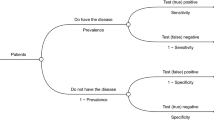Developing a strategy for investment in diagnostic technologies requires an understanding of the need for, and the health impact of, potential new tools, as well as the necessary performance characteristics and user requirements. In this paper, we outline an approach for modelling the health benefits of new diagnostic tools.

Similar content being viewed by others
References
Samuelson, P. A. Foundations of Economic Analysis (Harvard Univ. Press, Cambridge, 1947).
Girosi, F. et al. Determining the Priority Global Health Needs and Quantifying the Health Benefits Resulting from the Introduction of New Diagnostics in the Developing World WR-418-HLTH (RAND Corporation, Santa Monica, 2006).
Olmsted, S. S., Derose, K. P. & Beighley, C. M. Determining Access to Care and User Requirements for Diagnostic Tests in Developing Countries WR-423-HLTH (RAND Corporation, Santa Monica, 2006).
Aday, L. A. & Awe, W. C. in Handbook of Health Behavior Research I: Personal and Social Determinants (ed. Gochman, D. S.) 153–172 (Plenum Press, New York, 1997).
Lim, Y-W. et al. Reducing the global burden of acute lower respiratory infections in children: the potential contribution of new diagnostic tests. Nature S1, 9–18 (2006).
Aledort, J. E. et al. Reducing the burden of sexually transmitted infections in resource-limited settings: the role of improved diagnostics. Nature S1, 59–72 (2006).
Acknowledgements
The authors thank A. Noriega-Minichiello (World Health Organization, Switzerland). The authors also thank L. Lu (Roche Diagnostics, USA for helpful comments on an earlier draft of this paper.
Author information
Authors and Affiliations
Corresponding author
Additional information
This article has not been written or reviewed by the Nature editorial team and Nature takes no responsibility for the accuracy or otherwise of the information provided.
Rights and permissions
About this article
Cite this article
Girosi, F., Olmsted, S., Keeler, E. et al. Developing and interpreting models to improve diagnostics in developing countries. Nature 444 (Suppl 1), 3–8 (2006). https://doi.org/10.1038/nature05441
Published:
Issue Date:
DOI: https://doi.org/10.1038/nature05441
- Springer Nature Limited
This article is cited by
-
Evaluation of the routine implementation of pulse oximeters into integrated management of childhood illness (IMCI) guidelines at primary health care level in West Africa: the AIRE mixed-methods research protocol
BMC Health Services Research (2022)
-
Leveraging gains from African Center for Integrated Laboratory Training to combat HIV epidemic in sub-Saharan Africa
BMC Health Services Research (2021)
-
Integrated community case management by drug sellers influences appropriate treatment of paediatric febrile illness in South Western Uganda: a quasi-experimental study
Malaria Journal (2017)
-
On-chip Extraction of Intracellular Molecules in White Blood Cells from Whole Blood
Scientific Reports (2015)
-
Assessment of the proportion of neonates and children in low and middle income countries with access to a healthcare facility: A systematic review
BMC Research Notes (2011)





